Global Research Trends in Engineered Soil Development through Stabilisation: Scientific Production and Thematic Breakthrough Analysis
Abstract
:1. Introduction
2. Scientometrics and Research Significance
3. Methodology
3.1. Method
3.2. Search Query
3.3. Inclusion/Exclusion Criteria
3.4. Data Analysis
3.4.1. Analysis of Overall Growth Trend
3.4.2. Top Ten Publishing Countries
3.4.3. Top Ten Research-Producing Institutions
3.4.4. Most Prolific Authors
3.4.5. Three-Factor Analysis
- (a)
- Keywords, authors, and countries
- (b)
- Thematic evolution of keywords
3.4.6. Thematic Map
3.4.7. Thematic Focus on Field of Development of Engineered Soil through Soil Stabilisation
- (a)
- Keyword analysis, co-occurrence network, and trend topics
4. Limitations of Study and Recommendations
5. Conclusions
Author Contributions
Funding
Data Availability Statement
Conflicts of Interest
References
- Mohamed, O.A. Effects of the curing regime, acid exposure, alkaline activator dosage, and precursor content on the strength development of mortar with alkali-activated slag and fly ash binder: A critical review. Polymers 2023, 15, 1248. [Google Scholar] [CrossRef] [PubMed]
- Singh, A.K.; Bedi, R.; Kaith, B.S. Composite materials based on recycled polyethylene terephthalate and their properties–A comprehensive review. Compos. B. Eng. 2021, 219, 10892. [Google Scholar] [CrossRef]
- Zafar, T.; Ansari, M.A.; Husain, A. Soil stabilization by reinforcing natural and synthetic fibers—A state of the art review. Mater. Today Proc. 2023, in press. [Google Scholar] [CrossRef]
- Ito, A.; Wagai, R. Global distribution of clay-size minerals on land surface for biogeochemical and climatological studies. Sci. Data 2017, 4, 170103. [Google Scholar] [CrossRef] [PubMed]
- Ramos, M.R.; Uhlmann, A.; Dedecek, R.A.; Curcio, G.R. Clay mineralogy and genesis of fragipan in soils from Southeast Brazil. Catena 2015, 135, 22–28. [Google Scholar] [CrossRef]
- Behnood, A. Soil and clay stabilization with calcium- and non-calcium-based additives: A state-of-the-art review of challenges, approaches and techniques. Transp. Geotech. 2018, 17, 14–32. [Google Scholar] [CrossRef]
- Ikeagwuani, C.C.; Obeta, I.N.; Agunwamba, J.C. Stabilization of black cotton soil subgrade using sawdust ash and lime. Soils Found. 2019, 59, 162–175. [Google Scholar] [CrossRef]
- Ikeagwuani, C.C.; Nwonu, D.C. Emerging trends in expansive soil stabilization: A review. J. Rock Mech. Geotech. Eng. 2019, 11, 423–440. [Google Scholar] [CrossRef]
- Munirwan, R.P.; Mohd Taib, A.; Taha, M.R.; Abd Rahman, N.; Munirwansyah, M. Utilization of coffee husk ash for soil stabilization: A systematic review. Phys. Chem. Earth 2022, 128, 103252. [Google Scholar] [CrossRef]
- Ezzat, S.M. A critical review on microbially induced carbonate precipitation for soil stabilization: The global experiences and future prospective. Pedosphere 2023. [Google Scholar] [CrossRef]
- Bozyigit, I.; Zingil, H.O.; Altun, S. Performance of eco-friendly polymers for soil stabilization and their resistance to freeze–thaw action. Constr. Build. Mater. 2023, 379, 131133. [Google Scholar] [CrossRef]
- Ijaz, N.; Ye, W.; ur Rehman, Z.; Ijaz, Z. Novel application of low carbon limestone calcined clay cement (LC3) in expansive soil stabilization: An eco-efficient approach. J. Clean. Prod. 2022, 371, 133492. [Google Scholar] [CrossRef]
- Zada, U.; Jamal, A.; Iqbal, M.; Eldin, S.M.; Almoshaogeh, M.; Bekkouche, S.R.; Almuaythir, S. Recent advances in expansive soil stabilization using admixtures: Current challenges and opportunities. Case Stud. Constr. Mater. 2023, 18, e01985. [Google Scholar] [CrossRef]
- Wang, X.; Kim, S.; Wu, Y.; Liu, Y.; Liu, T.; Wang, Y. Study on the optimization and performance of GFC soil stabiliser based on response surface methodology in soft soil stabilization. Soils Found. 2023, 63, 101278. [Google Scholar] [CrossRef]
- Al-Atroush, M.E.; Sebaey, T.A. Stabilization of expansive soil using hydrophobic polyurethane foam: A review. Transp. Geotech. 2021, 27, 100494. [Google Scholar] [CrossRef]
- Jiang, Q.; He, Y.; Wu, Y.; Dian, B.; Zhang, J.; Li, T.; Jiang, M. Solidification/stabilization of soil heavy metals by alkaline industrial wastes: A critical review. Environ. Pollut. 2022, 312, 120094. [Google Scholar] [CrossRef] [PubMed]
- Luo, Z.; Zhang, B.; Zou, J.; Luo, B. Sulfate erosion resistance of slag-fly ash based geopolymer stabilised soft soil under semi-immersion condition. Case Stud. Constr. Mater. 2022, 17, e01506. [Google Scholar] [CrossRef]
- Sundary, D.; Munirwan, R.P.; Al-Huda, N.; Munirwansyah Sungkar, M.; Jaya, R.P. Shear strength performance of dredged sediment soil stabilised with lime. Phys. Chem. Earth 2022, 128, 103299. [Google Scholar] [CrossRef]
- Dai, D.; Peng, J.; Wei, R.; Li, L.; Lin, H. Improvement in dynamic behaviors of cement-stabilized soil by super-absorbent-polymer under cyclic loading. Soil Dyn. Earthq. Eng. 2022, 163, 107554. [Google Scholar] [CrossRef]
- Espinosa, A.B.; López-Ausín, V.; Fiol, F.; Serrano-López, R.; Ortega-López, V. Analysis of the deformational behavior of a clayey foundation soil stabilized with ladle furnace slag (LFS) using a finite element software. Mater. Today Proc. 2023. [Google Scholar] [CrossRef]
- Hamid, W.; Alnuaim, A. Evaluation of the durability and strength of stabilized sabkha soil with geopolymer. Case Stud. Constr. Mater. 2023, 18, e02051. [Google Scholar] [CrossRef]
- Kommidi, S.R.; Akula, P.; Kim, Y.-R.; Little, D.N.; Rushing, J. Cyclic strain sweep testing-analysis to evaluate the mechanical characteristics of stabilized soils. Transp. Geotech. 2023, 39, 100944. [Google Scholar] [CrossRef]
- Nan, J.; Liu, J.; Chang, D.; Li, X. Mechanical characteristics and microstructure study of saline soil stabilized by quicklime after curing and freeze-thaw cycle. Cold Reg. Sci. Technol. 2022, 201, 103625. [Google Scholar] [CrossRef]
- Pandey, B.K.; Rajesh, S.; Chandra, S. Time-dependent behavior of embankment resting on soft clay reinforced with encased stone columns. Transp. Geotech. 2022, 36, 100809. [Google Scholar] [CrossRef]
- Ren, F.; Shi, J.; Zhao, D.; Huang, L. Spatiotemporal variation of soil heavy metals in China: The pollution status and risk assessment. Sci. Total Environ. 2023, 871, 161768. [Google Scholar] [CrossRef]
- Yu, C.; Cui, C.; Wang, Y.; Zhao, J.; Wu, Y. Strength performance and microstructural evolution of carbonated steel slag stabilized soils in the laboratory scale. Eng. Geol. 2021, 295, 106410. [Google Scholar] [CrossRef]
- Owino, A.O.; Hossain, Z. The influence of basalt fiber filament length on shear strength development of chemically stabilized soils for ground improvement. Constr. Build. Mater. 2023, 374, 130930. [Google Scholar] [CrossRef]
- Keramatikerman, M.; Chegenizadeh, A.; Nikraz, H. Effect of GGBFS and lime binders on the engineering properties of clay. Appl. Clay Sci. 2016, 132–133, 722–730. [Google Scholar] [CrossRef]
- Saberian, M.; Li, J.; Boroujeni, M.; Law, D.; Li, C.-Q. Application of demolition wastes mixed with crushed glass and crumb rubber in pavement base/subbase. Resour. Conserv. Recycl. 2020, 156, 104722. [Google Scholar] [CrossRef]
- Sol-Sánchez, M.; Castro, J.; Ureña, C.; Azañón, J.M. Stabilization of clayey and marly soils using industrial wastes: pH and laser granulometry indicators. Eng. Geol. 2016, 200, 10–17. [Google Scholar] [CrossRef]
- Al-Amoudi, O.S.B.; Khan, K.; Al-Kahtani, N.S. Stabilization of a Saudi calcareous marl soil. Constr. Build. Mater. 2010, 24, 1848–1854. [Google Scholar] [CrossRef]
- Etim, R.K.; Eberemu, A.O.; Osinubi, K.J. Stabilization of black cotton soil with lime and iron ore tailings admixture. Transp. Geotech. 2017, 10, 85–95. [Google Scholar] [CrossRef]
- Al-Swaidani, A.; Hammoud, I.; Meziab, A. Effect of adding natural pozzolana on geotechnical properties of lime-stabilised clayey soil. J. Rock Mech. Geotech. Eng. 2016, 8, 714–725. [Google Scholar] [CrossRef]
- Eisazadeh, A.; Kassim, K.A.; Nur, H. Characterization of phosphoric acid- and lime-stabilised tropical lateritic clay. Environ. Earth Sci. 2011, 63, 1057–1066. [Google Scholar] [CrossRef]
- Consoli, N.C.; Foppa, D.; Festugato, L.; Heineck, K.S. Key parameters for strength control of artificially cemented soils. J. Mater. Civ. Eng. 2007, 133, 197–205. [Google Scholar] [CrossRef]
- Horpibulsuk, S.; Katkan, W.; Sirilerdwattana, W.; Rachan, R. Strength development in cement stabilised low plasticity and coarse grained soils: Laboratory and field study. Soils Found. 2006, 46, 351–366. [Google Scholar] [CrossRef]
- Horpibulsuk, S.; Rachan, R.; Chinkulkijniwat, A.; Raksachon, Y.; Suddeepong, A. Analysis of strength development in cement-stabilised silty clay from microstructural considerations. Constr. Build. Mater. 2010, 24, 2011–2021. [Google Scholar] [CrossRef]
- Basha, E.A.; Hashim, R.; Mahmud, H.B.; Muntohar, A.S. Stabilization of residual soil with rice husk ash and cement. Constr. Build. Mater. 2005, 19, 448–453. [Google Scholar] [CrossRef]
- Yong, R.N.; Ouhadi, V.R. Experimental study on instability of bases on natural and lime/cement-stabilised clayey soils. Appl. Clay Sci. 2007, 35, 238–249. [Google Scholar] [CrossRef]
- Kukko, H. Stabilization of clay with inorganic by-products. J. Mater. Civ. Eng. 2000, 12, 307–309. [Google Scholar] [CrossRef]
- Ardah, A.; Chen, Q.; Abu-Farsakh, M. Evaluating the performance of very weak subgrade soils treated/stabilised with cementitious materials for sustainable pavements. Transp. Geotech. 2017, 11, 107–119. [Google Scholar] [CrossRef]
- Petry, T.M.; Little, D.N. Review of stabilization of clays and expansive soils in pavements and lightly loaded structures—History, practice, and future. J. Mater. Civ Eng. 2002, 14, 446–460. [Google Scholar] [CrossRef]
- Barman, D.; Dash, S.K. Stabilization of expansive soils using chemical additives: A review. J. Rock Mech. Geotech. Eng. 2022, 14, 1319–1342. [Google Scholar] [CrossRef]
- Huang, J.; Kogbara, R.B.; Hariharan, N.; Masad, E.A.; Little, D.N. A state-of-the-art review of polymers used in soil stabilization. Constr. Build. Mater. 2021, 305, 124685. [Google Scholar] [CrossRef]
- Jiang, X.; Huang, Z.; Ma, F.; Luo, X. Analysis of strength development and soil-water characteristics of rice husk ash-lime stabilised soft soil. Materials 2019, 12, 3873. [Google Scholar] [CrossRef] [PubMed]
- Khodabandeh, M.A.; Nagy, G.; Török, Á. Stabilization of collapsible soils with nanomaterials, fibers, polymers, industrial waste, and microbes: Current trends. Constr. Build. Mater. 2023, 368, 130463. [Google Scholar] [CrossRef]
- Pu, S.; Zhu, Z.; Huo, W. Evaluation of engineering properties and environmental effect of recycled gypsum stabilised soil in geotechnical engineering: A comprehensive review. Resour. Conserv. Recycl. 2021, 174, 105780. [Google Scholar] [CrossRef]
- Vijayan, D.S.; Parthiban, D. Effect of solid waste based stabilising material for strengthening of expansive soil- A review. Environ. Technol. Innov. 2020, 20, 101108. [Google Scholar] [CrossRef]
- Agbo, F.J.; Oyelere, S.S.; Suhonen, J.; Tukiainen, M. Scientific production and thematic breakthroughs in smart learning environments: A bibliometric analysis. Smart Learn. Environ. 2021, 8, 1. [Google Scholar] [CrossRef]
- Mahesh, V.; Gobinath, R.; Kırgız, M.S.; Shekar RP, V.; Shewale, M. Global trends of research productivity in natural fibre reinforced composites: Comprehensive scientometric analysis. J. Nat. Fibers 2022, 19, 13088–13105. [Google Scholar] [CrossRef]
- Saleem, F.; Khattak, A.; Ur Rehman, S.; Ashiq, M. Bibliometric analysis of green marketing research from 1977 to 2020. Publications 2021, 9, 1. [Google Scholar] [CrossRef]
- Aria, M.; Cuccurullo, C. bibliometrix: An R-tool for comprehensive science mapping analysis. J. Informetr. 2017, 11, 959–975. [Google Scholar] [CrossRef]
- Qian, Y.; Liu, Y.; Xu, X.; Sheng, Q.Z. Leveraging citation influences for modeling scientific documents. World Wide Web 2020, 23, 2281–2302. [Google Scholar] [CrossRef]
- Aksnes, D.W.; Langfeldt, L.; Wouters, P. Citations, citation indicators, and research quality: An overview of basic concepts and theories. SAGE Open 2019, 9, 215824401982957. [Google Scholar] [CrossRef]
- Shao, F.; Xu, J.; Kang, X.; Hu, Z.; Shao, Y.; Lu, C.; Zhao, C.; Ren, Y.; Zhang, J. An attempt to enhance the adsorption capacity of biochar for organic pollutants - Characteristics of CaCl2 biochar under multiple design conditions. Sci. Total Environ. 2023, 854, 158675. [Google Scholar] [CrossRef] [PubMed]
- Tang, Y.; Xiao, J.; Zhang, H.; Duan, Z.; Xia, B. Mechanical properties and uniaxial compressive stress-strain behavior of fully recycled aggregate concrete. Constr. Build. Mater. 2022, 323, 126546. [Google Scholar] [CrossRef]
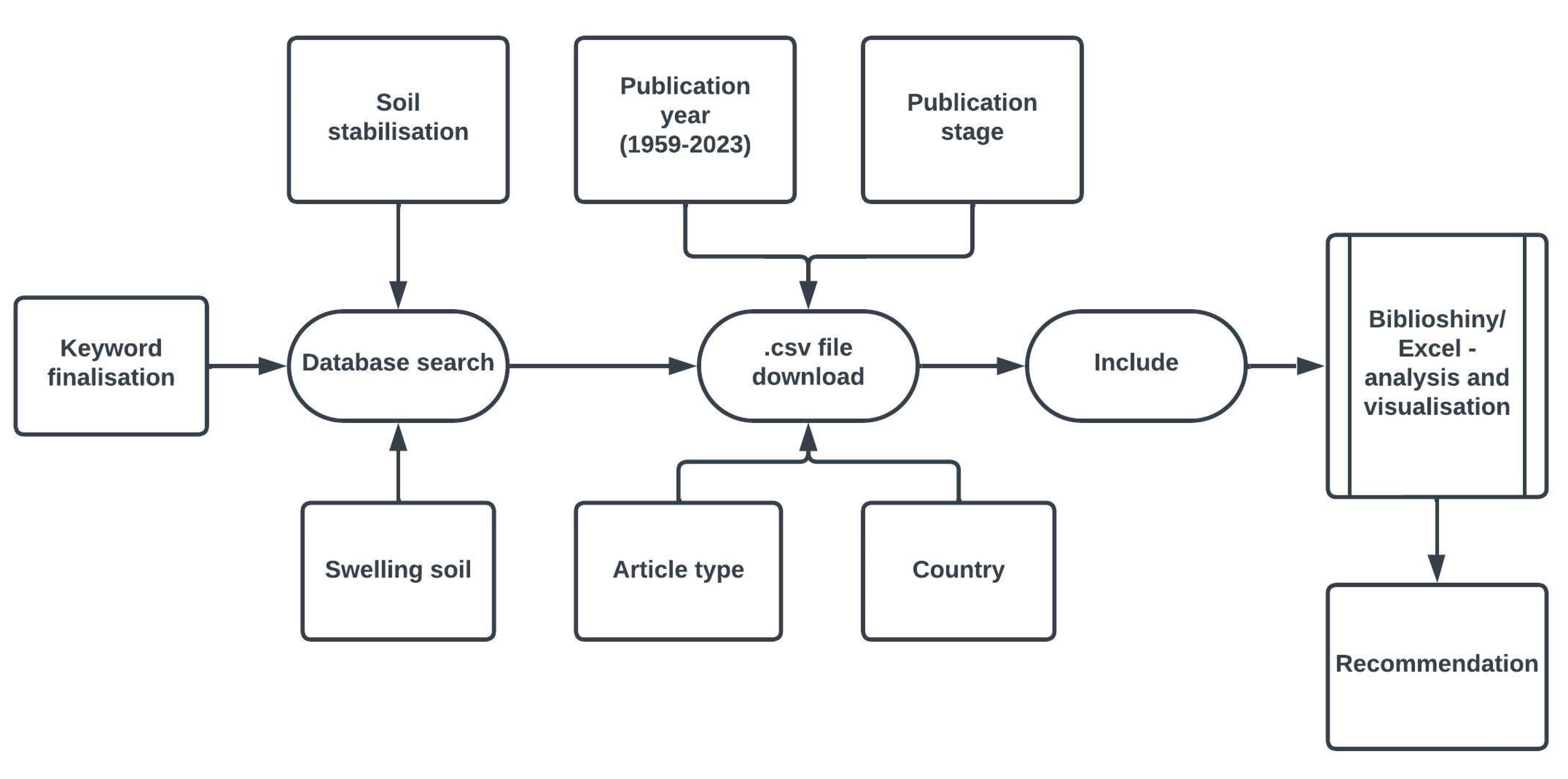
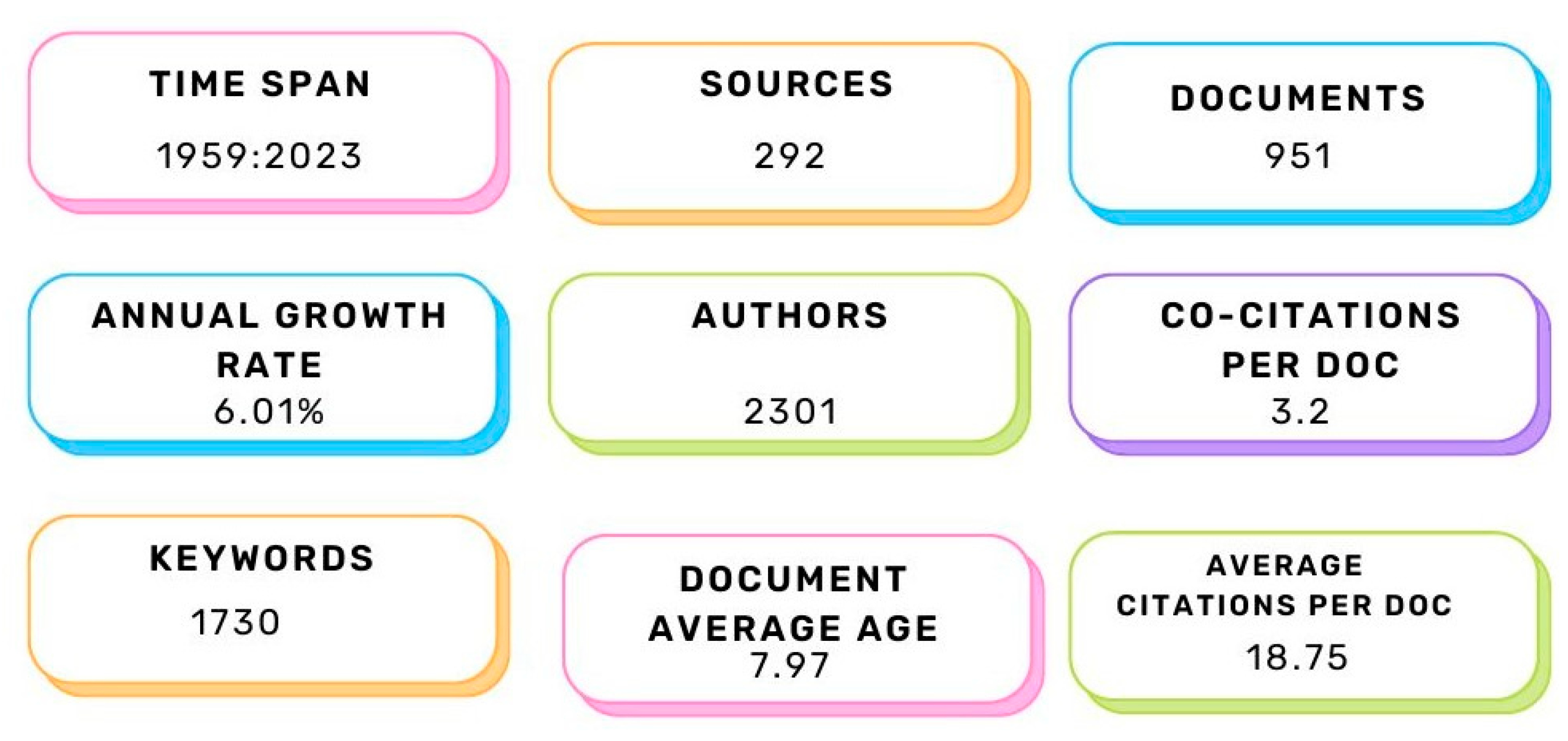

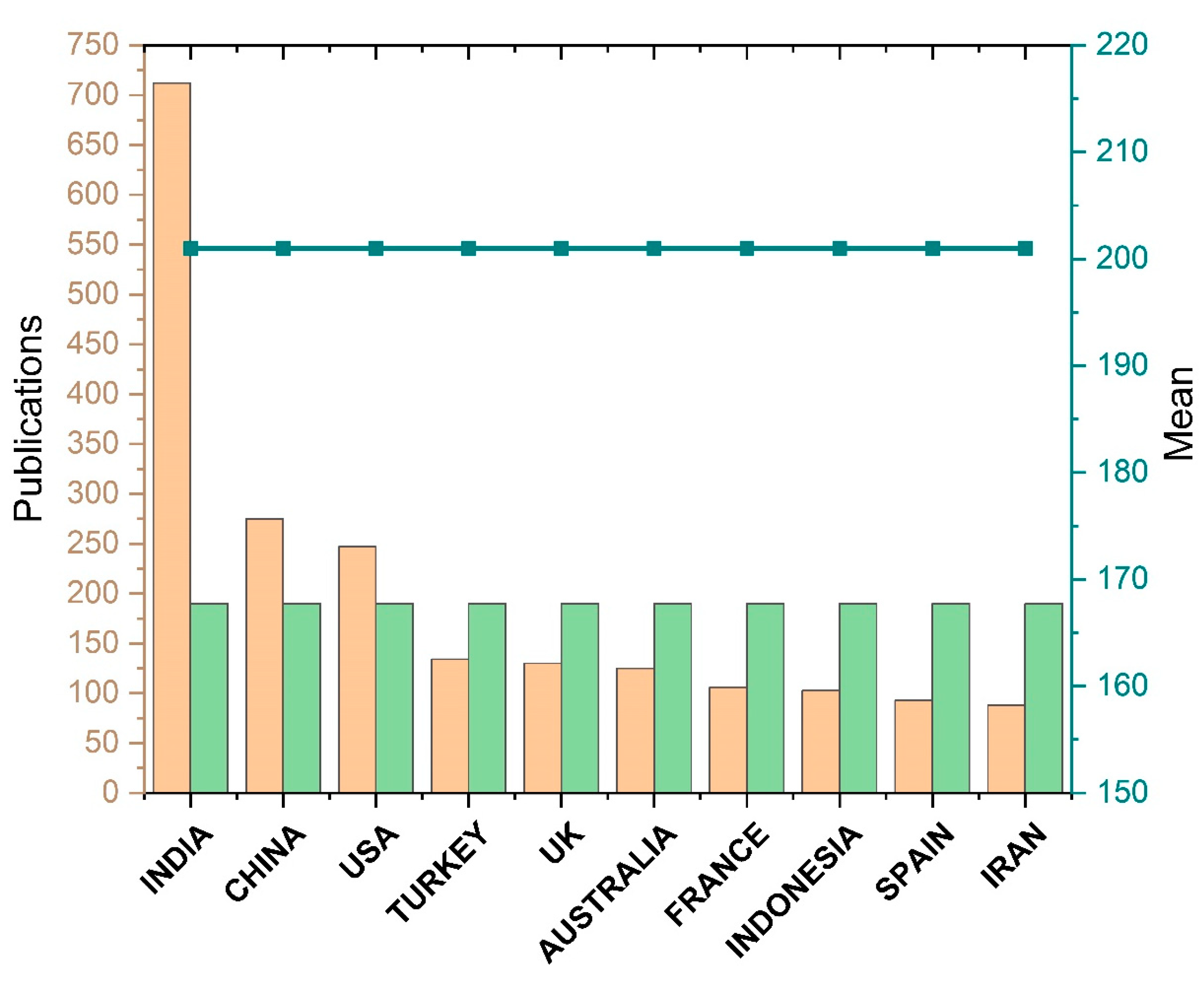
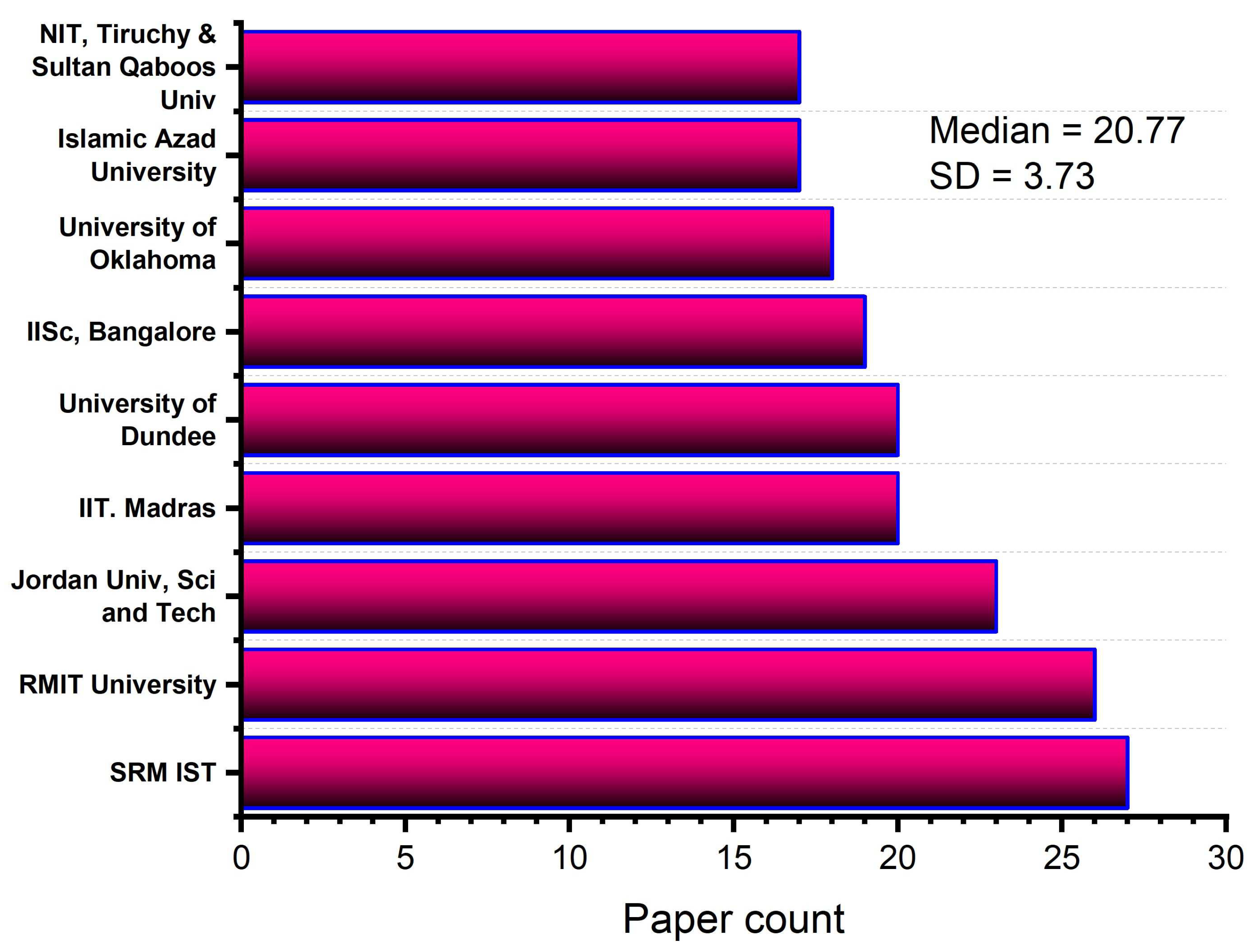
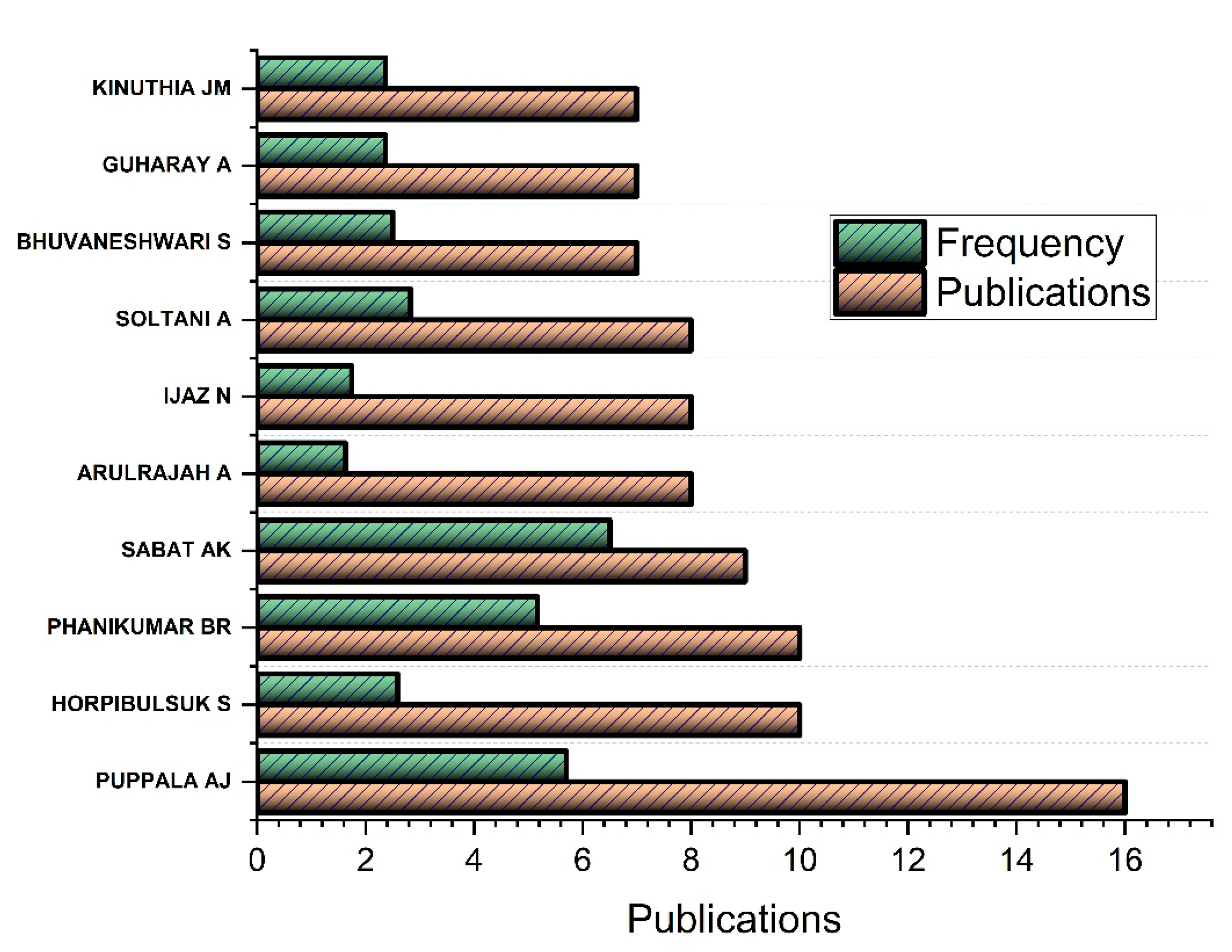
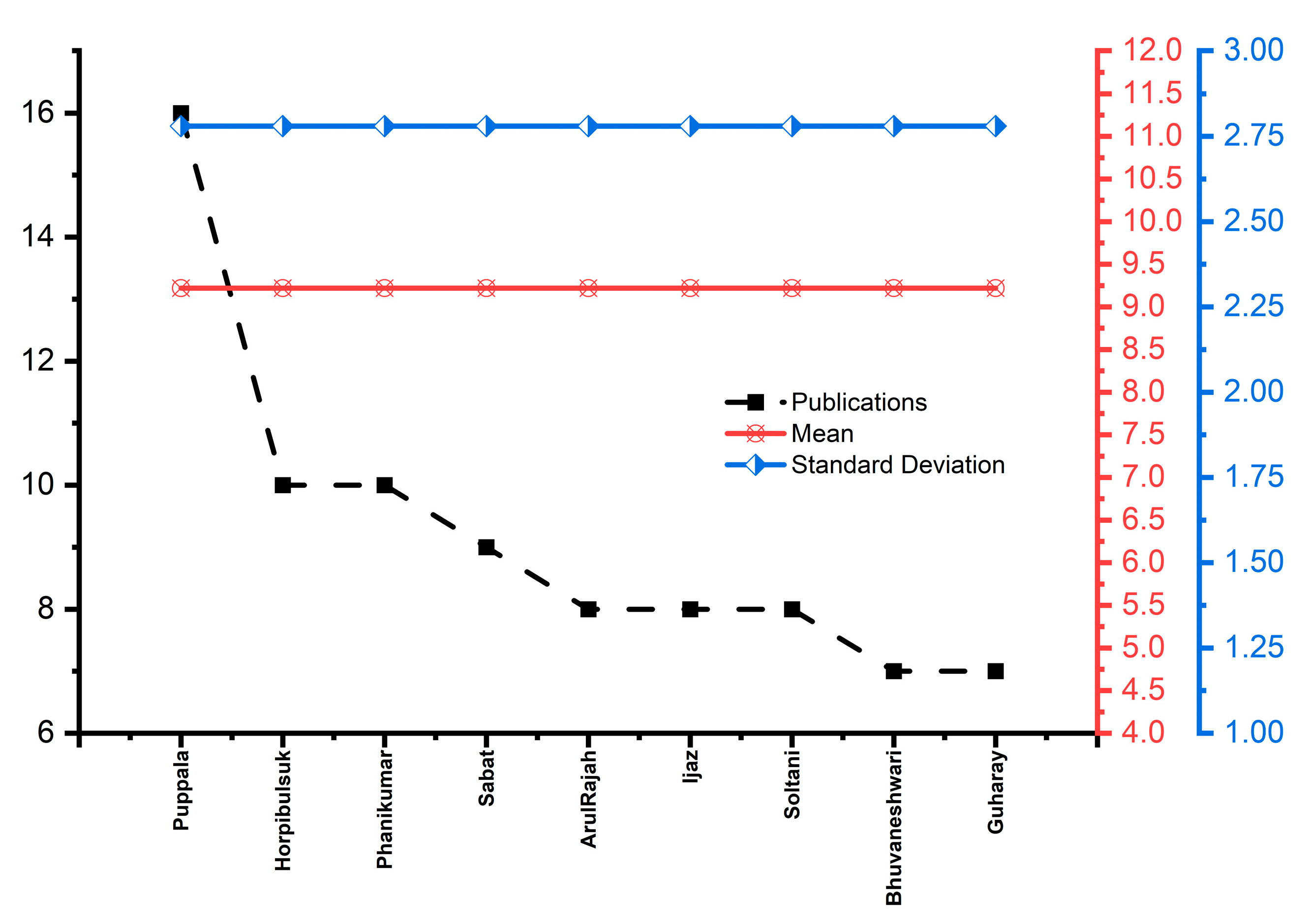
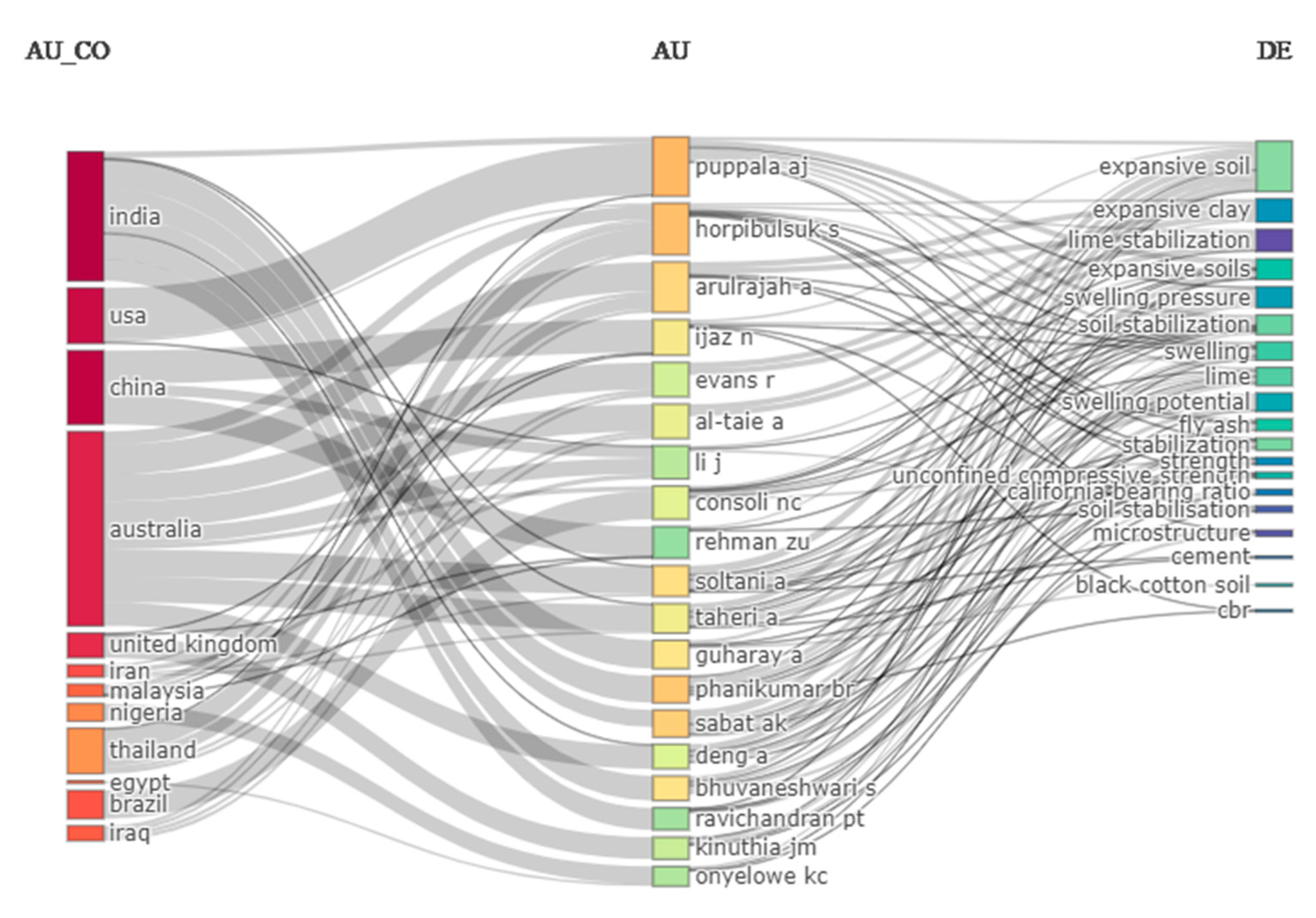
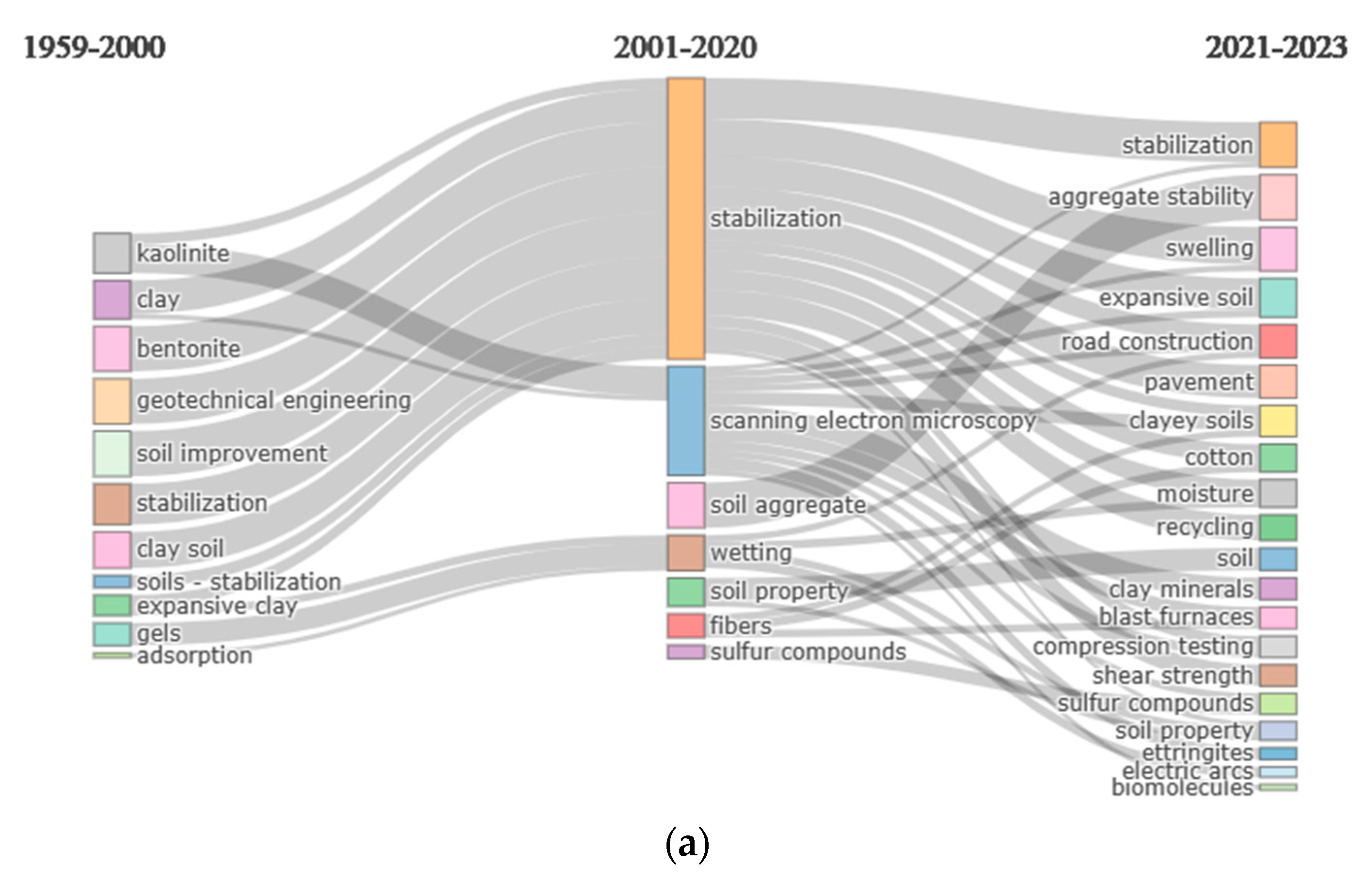
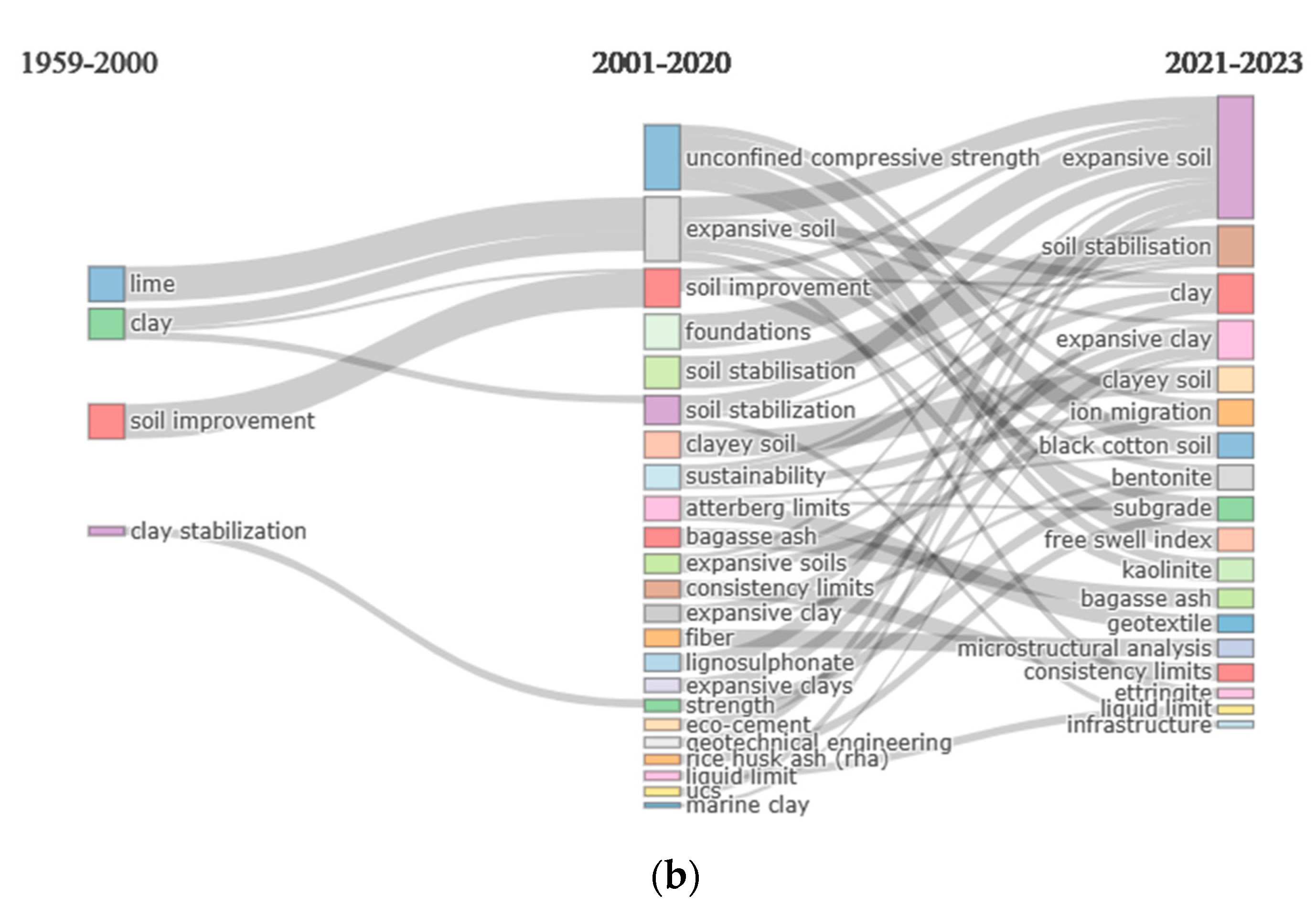
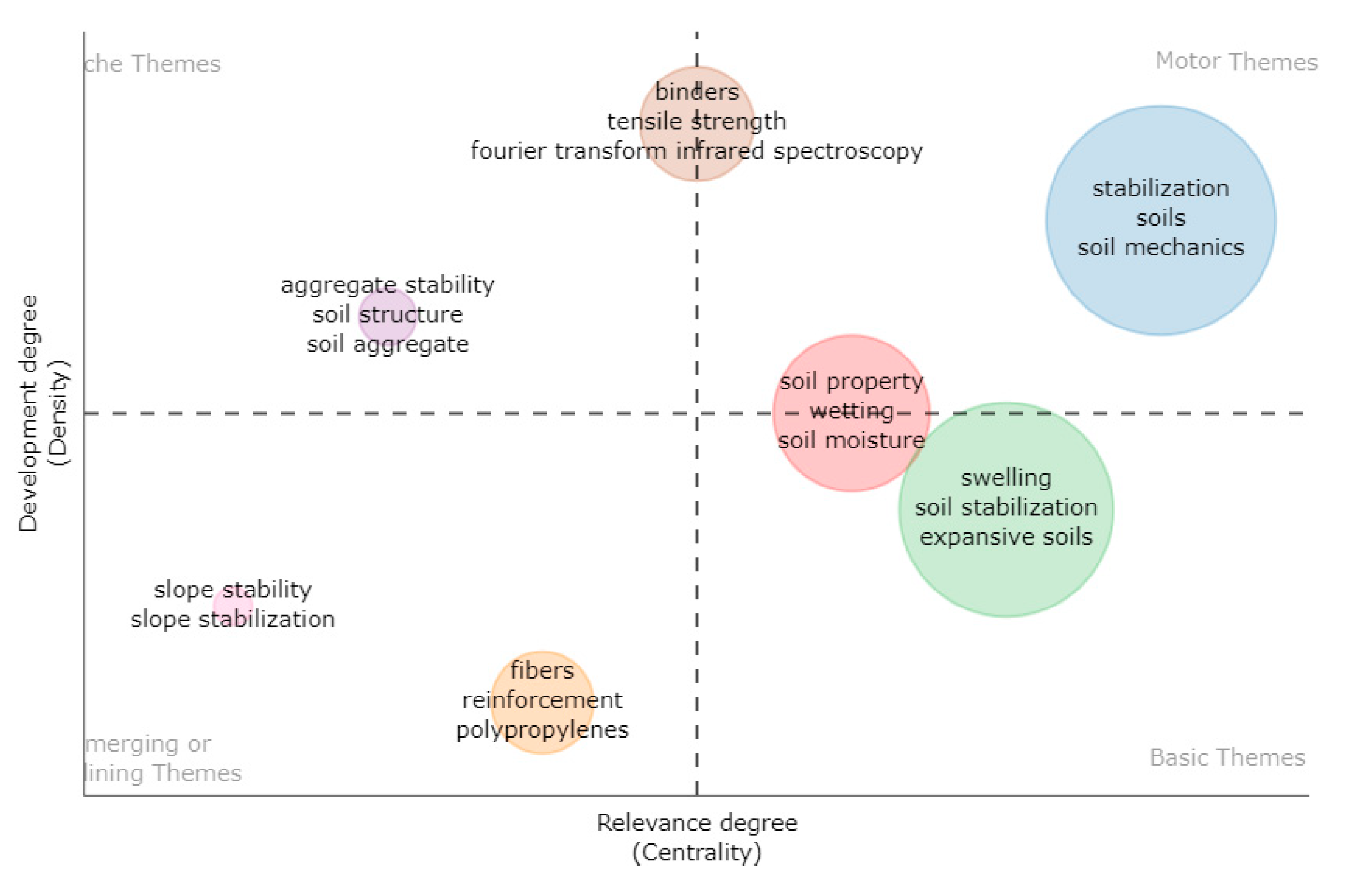
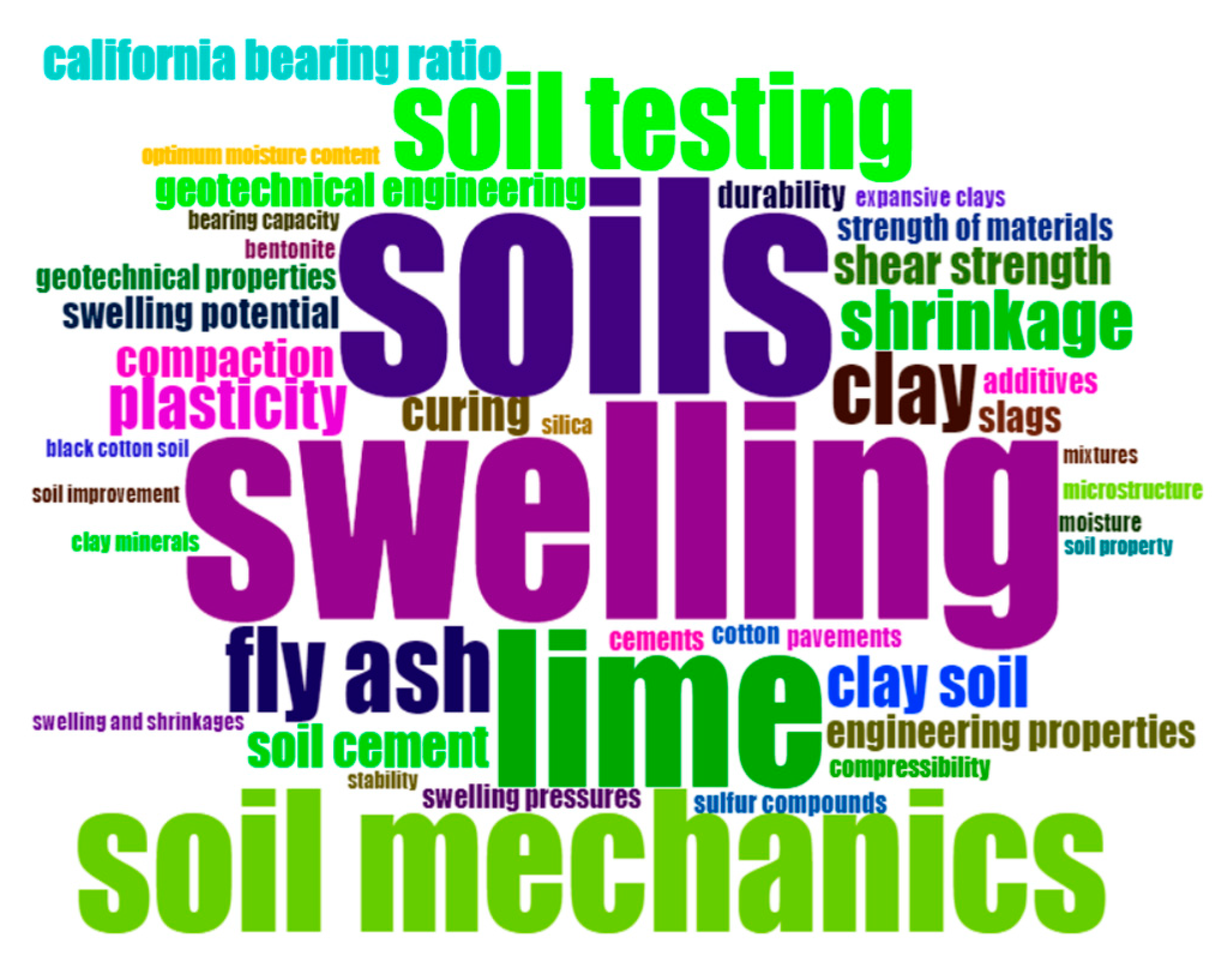
| Reference | Journal | Used Stabiliser | Performed Test | Type of Soil | Major Outcome |
|---|---|---|---|---|---|
| Zafar et al. [3] | Materials Today: Proceedings | Natural and synthetic fibres | CBR, UCS, aspect ratio, modulus of elasticity, swelling, compressibility | Expansive soil | Improvement of expansive soil characters |
| Pahlevi Munirwan et al. [9] | Physics and Chemistry of Earth, Parts A/B/C | Coffee husk ash | Chemical, physical, microstructural properties, water/CHA ratio, optimal burning | Subgrade soil | Enhancement of strength |
| Wang et al. [14] | Soils and Foundations | GFC soil stabiliser | Optimal ratio, UCS, SEM, XRD | Soft marine clay | Increase of strength |
| Al-Atroush and Sebaey [15] | Transportation Geotechnics | Hydrophobic polyurethane foam | Swell-shrink nature, chemical and physical, microstructural | Expansive soil | Reduction of swell–shrink nature |
| Luo et al. [17] | Case Studies in Construction Materials | Slag, fly ash based geopolymer | UCS, bearing capacity, mass, immersion | Soft soil | Increase of bearing capacity |
| Sundary et al. [18] | Physics and Chemistry of Earth, Parts A/B/C | Lime | Morphological and physical properties, strength, compressibility | Sediment soil | Change in morphology |
| Dai et al. [19] | Soil Dynamics and Earthquake Engineering | Super absorbent polymer | Triaxial test, consolidation, damping ratio, elastic modulus | Cement-stabilised soil | Obtaining high elastic modulus |
| Espinosa et al. [20] | Materials Today: Proceedings | Ladle furnace slag | PI, UCS, elasticity, CBR, shear strength | Clayey foundation soil | Increase of CBR |
| Hamid et al. [21] | Case Studies in Construction Materials | Geopolymer | UCS, MDD, OMC, compressive strength | Saline sabkha soil | Enhancement of strength |
| Kommidi et al. [22] | Transportation Geotechnics | Chemical stabilisers (C-A-H, C-S-H) | UCS, freeze–thaw, dynamic mechanical analysis, shear stress, strain energy | Subgrade soil | More freeze–thaw resistance |
| Nan et al. [23] | Cold Regions Science and Technology | Quick lime | UCS, FTC, freeze–thaw | Saline soil | More freeze–thaw resistance |
| Pandey et al. [24] | Transportation Geotechnics | Magnesium phosphate cement, jute fibre | UCS, elastic modulus, swelling | Kaolinitic soil | Good elastic modulus with reduced swell |
| Ren et al. [25] | Science of The Total Environment | Phosphogypsum slag-based cementitious materials | XRD, TGA, FTIR, XPS, SEM/EDS | Lead-contaminated soil | Leaching effect was analysed and strength variation was studied |
| Yu et al. [26] | Engineering Geology | Carbonated steel slag | UCS, D-W Cycles, Rm | Soft soils | High D-W resistance |
| Owino et al. [27] | Construction and Building Materials | Basalt fibre filaments | Triaxial test, OMC, MDD, SEM, XRD | Chemically stabilised weak soils | Improvement of shear strength |
Disclaimer/Publisher’s Note: The statements, opinions and data contained in all publications are solely those of the individual author(s) and contributor(s) and not of MDPI and/or the editor(s). MDPI and/or the editor(s) disclaim responsibility for any injury to people or property resulting from any ideas, methods, instructions or products referred to in the content. |
© 2023 by the authors. Licensee MDPI, Basel, Switzerland. This article is an open access article distributed under the terms and conditions of the Creative Commons Attribution (CC BY) license (https://creativecommons.org/licenses/by/4.0/).
Share and Cite
Ravindran, G.; Bahrami, A.; Mahesh, V.; Katman, H.Y.B.; Srihitha, K.; Sushmashree, A.; Nikhil Kumar, A. Global Research Trends in Engineered Soil Development through Stabilisation: Scientific Production and Thematic Breakthrough Analysis. Buildings 2023, 13, 2456. https://doi.org/10.3390/buildings13102456
Ravindran G, Bahrami A, Mahesh V, Katman HYB, Srihitha K, Sushmashree A, Nikhil Kumar A. Global Research Trends in Engineered Soil Development through Stabilisation: Scientific Production and Thematic Breakthrough Analysis. Buildings. 2023; 13(10):2456. https://doi.org/10.3390/buildings13102456
Chicago/Turabian StyleRavindran, Gobinath, Alireza Bahrami, Vutukuru Mahesh, Herda Yati Binti Katman, Katakam Srihitha, Alamadri Sushmashree, and Alugoju Nikhil Kumar. 2023. "Global Research Trends in Engineered Soil Development through Stabilisation: Scientific Production and Thematic Breakthrough Analysis" Buildings 13, no. 10: 2456. https://doi.org/10.3390/buildings13102456
APA StyleRavindran, G., Bahrami, A., Mahesh, V., Katman, H. Y. B., Srihitha, K., Sushmashree, A., & Nikhil Kumar, A. (2023). Global Research Trends in Engineered Soil Development through Stabilisation: Scientific Production and Thematic Breakthrough Analysis. Buildings, 13(10), 2456. https://doi.org/10.3390/buildings13102456








